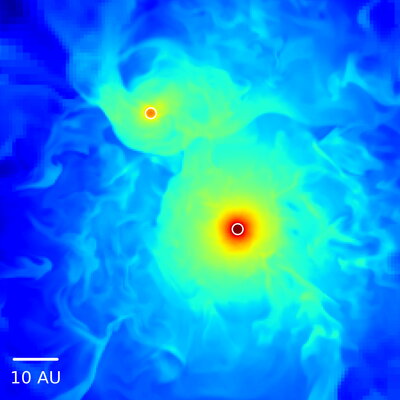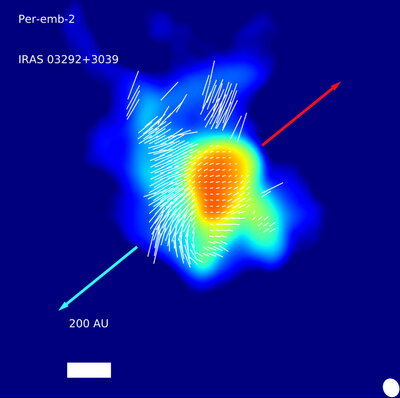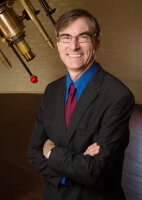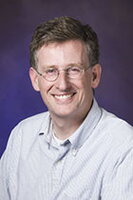
The origin, formation, and evolution of stars and planets link the interstellar components of the interstellar medium in galaxies to planets and life.
Research Highlights

Common Envelope Evolution
In order for two black holes to merge due to gravitational wave emission, some other dynamical mechanism must bring them close together. We perform hydrodynamical simulations of interacting binary star systems including black hole progenitors to understand better whether common envelopes can provide the necessary amount of inspiral.
Links to research groups and facilities: Paul Ricker

Formation of the Moon
The Moon is believed to have been formed in a cataclysmic giant impact between planet-sized bodies that lofted a disk of melted and vaporized rock into orbit around the Earth. That disk later condensed to form the Moon. We are interested in computational modeling of this disk using a realistic equation of state and in assessing the dynamical importance of magnetic fields on the outcome.
Links to research groups and facilities: Charles Gammie

Magnetic Fields in Protostars
The formation of stars and planets is fundamentally linked to the magnetic field, which plays an important role during the collapse process, but also during the accretion of material down to the protostar itself. Using ALMA, we can observe polarized light from circumstellar dust that measures magnetic fields, scattered light, and dust grains aligned by radiation anisotropy, providing insights into the star and planet formation process. Using theoretical techniques, we can predict the importance of the magnetic field during the collapse process and the impact on star formation observations.
Links to research groups and facilities: Leslie Looney, Telemachos Mouschovias, ALMA, VLA

Near-Earth Supernova Explosions
Multiple massive stars exploded near the Earth in the past 10 million years, and rained their debris onto the Solar System. This supernova eject has been observed in the form of radioactive iron atoms, found in ancient samples of deep-ocean material found around the globe, and also on the Moon. So for the first time we can use sea sediments and lunar cores as telescopes, revealing explosions before recorded human history, and probing the nuclear fires that power exploding stars. Furthermore, an explosion so close to Earth was probably a “near miss,” which emitted intense and possibly harmful radiation that may have affected the biosphere.
Links to research groups and facilities: Brian Fields

Transiting exoplanets
Planets orbiting other stars, or exoplanets, are an important focus of contemporary research in astronomy and astrophysics. These individual exoplanets and their organization in planetary systems around their host stars provide important information about the nature and origins of our own solar system. Exoplanets can be detected using multiple techniques. One common method, particularly for space-based wide-field exoplanet telescopes such as Kepler and TESS, relies on detecting the drop in apparent brightness of the host star if an exoplanet transits the star along the line of sight. As a collaborative project with the UIUC ECE department, we have developed new exoplanet detection techniques that are less sensitive to residual systematic noise in the transit light curves. In addition, we have examined the general detectability of exoplanets in large contemporary sky surveys sensitive to variable or transient objects.
Links to research groups and facilities: Athol Kemball
Updated 1/6/2025
Faculty working in Stars and Planets







